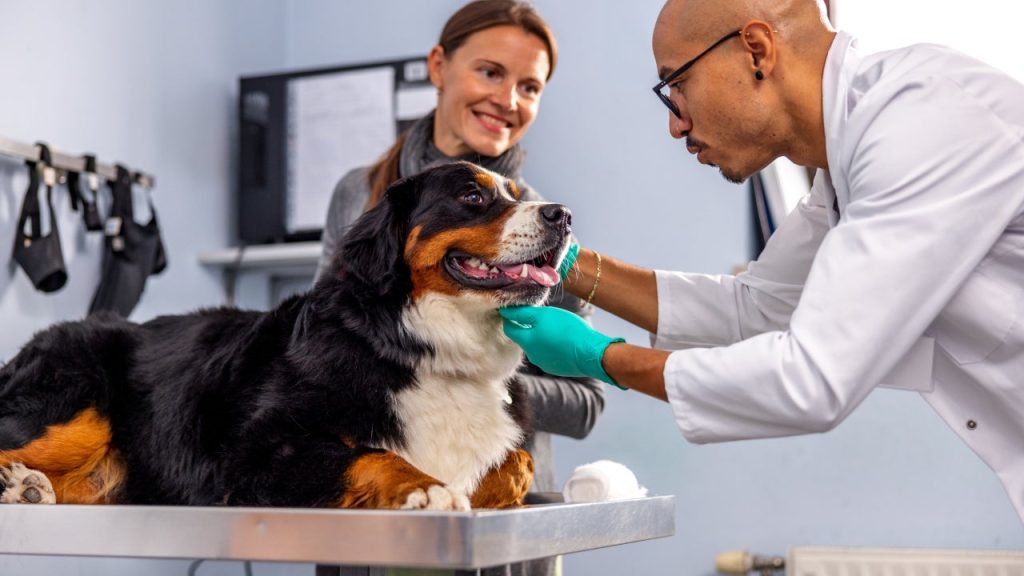Key takeaways
- Pet insurance policies typically cover accidents, illnesses and sometimes preventive care, but the specifics differ across providers and plan types.
- Accident and illness plans cover unexpected accidents and a range of illnesses, including hereditary conditions and serious diseases like cancer.
- Routine care such as vaccinations, annual exams and flea and tick prevention typically require a wellness add-on, which helps cover preventive and routine veterinary expenses.
- Common exclusions include pre-existing conditions, cosmetic procedures and behavioral therapies.
Pet insurance is designed to help pet parents manage the unexpected costs of veterinary care, providing peace of mind about your furry companion’s health. But what exactly does pet insurance cover? From routine check-ups to emergency treatments, pet insurance can vary greatly depending on the plan and provider you choose.
It’s helpful to learn the common types of coverage available so you can make informed decisions about protecting your pet. Whether you want coverage for accidents, illnesses or preventive care, understanding what your policy covers is key to ensuring your pet gets the care they deserve.
Types of pet insurance coverage
There are three main types of pet insurance coverage available, each offering different levels of protection. Understanding these can help you choose the best plan for your pet’s needs and your budget.
Accident-only coverage
Accident-only plans cover expenses related to injuries resulting from accidents. This includes broken bones, cuts, poisoning and the ingestion of foreign objects. Accident-only plans are generally more affordable but do not cover illnesses or preventive care.
Accident and illness coverage
This is the most common type of pet insurance. It covers both accidents and illnesses, including coverage for conditions such as cancer, infections and hereditary diseases. These plans are more comprehensive and slightly more expensive than accident-only plans.
Wellness coverage
Wellness plans, also known as preventive care plans, cover routine and preventive care. These plans may include vaccinations, annual check-ups, flea and tick prevention and dental cleanings. Some pet insurance companies offer wellness coverage as an add-on to accident and illness plans.
Coverage can vary by provider, but the following are common services typically included in wellness plans:
- Annual physical exams
- Dental care
- Microchipping
- Pest (flea, tick and heartworm) prevention
- Routine blood work and diagnostics
- Spaying and neutering
- Vaccinations
| Accident only plans | Accident and illness plans | Wellness | |
|---|---|---|---|
| *In the case of an accident-only policy, pet insurance coverage will only be for medications or procedures due to the accident or illness covered by the policy. | |||
| Acupuncture, chiropractor, physiotherapy | ✓ | ✓ | X |
| Broken bones, lacerations, torn ligaments | ✓ | ✓ | X |
| Common illnesses such as vomiting, diarrhea and eye and ear infections | X | ✓ | X |
| Diagnostics such as X-rays, CT scans, ultrasound and blood tests | ✓ | ✓ | X |
| Poisonings, ingestion of foreign object | ✓ | ✓ | X |
| Prescription medications for infections, pain and inflammation | ✓ | ✓ | X |
| Procedures such as surgery, chemotherapy and colonoscopy | ✓ | ✓ | X |
| Routine check-ups, vaccinations, pest prevention | X | X | ✓ |
| Serious illnesses such as cancer, diabetes and heart disease | X | ✓ | X |
What pet insurance covers
Pet insurance coverage can differ widely depending on the provider and the specific plan you choose. Despite these variations, most policies offer protection for a range of treatments and procedures.
Accidents
Coverage for accidents is a staple in pet insurance policies. This includes injuries from car accidents, falls, or bites from other animals. Treatments for these injuries may include emergency care, surgery, hospitalization and medication required for the healing process.
Types of accidents can include:
- Bee stings and bite wounds from other animals
- Eye injuries
- Ingestion of foreign objects, poison or exposure to toxins
- Lacerations
- Sprains or broken bones
- Torn ACL (anterior cruciate ligament)
Chronic conditions
Chronic conditions like allergies, arthritis and diabetes require ongoing treatment and medication. Pet insurance can help manage the costs of these long-term conditions, making it easier for pet owners to provide continuous care.
Emergency care
Emergency veterinary care can be prohibitively expensive. Pet insurance can cover emergency visits, treatments and surgeries, providing peace of mind during stressful situations.
Diagnostic tests
Pet insurance often covers the cost of diagnostic tests, including blood tests, X-rays, MRIs, and ultrasounds. These tests are essential for accurately diagnosing conditions and planning appropriate treatments.
Hereditary and congenital conditions
Some breeds are prone to hereditary and congenital conditions, such as hip dysplasia or heart disease. Comprehensive pet insurance plans often cover these conditions, though some may have waiting periods before coverage begins.
Illnesses
Most pet insurance plans cover a spectrum of illnesses, from minor infections to serious diseases like cancer. Coverage typically includes diagnostics, medications and treatments such as chemotherapy or surgery.
Illnesses include things like:
- Allergies
- Arthritis
- Cancer
- Diabetes
- Diarrhea and/or vomiting
- Heart disease
- Kidney disease
- Liver failure
- Skin conditions
- Thyroid disorders
- Urinary tract infections
Prescription medications
Many pet insurance plans cover the cost of pet medication, including antibiotics, pain relievers and treatments for chronic conditions.
Pet insurance coverage exclusions
While pet insurance offers extensive coverage, there are some common exclusions to be aware of.
Behavioral therapies
Behavioral conditions such as destructive chewing, excessive licking or fur pulling may cause harm to your furkid and be stressful for your family. Unless you opt-in for additional benefits, few pet insurance providers cover the costs for treatments and therapies relating to behavioral issues.
Breeding and pregnancy
In our research for the best pet insurance companies, we did not come across any that cover costs relating to breeding, pregnancy and birth in their standard policies. However, AKC and Trupanion reimburse these costs if you add a breeding rider to your policy.
Cosmetic procedures
Cosmetic procedures such as tail docking, ear cropping and declawing are generally not covered by pet insurance, as they are not deemed medically necessary.
Pre-existing conditions
In pet insurance, pre-existing conditions refer to any illness, injury or health issue that your pet shows symptoms of or is diagnosed with before the start of the insurance policy. These conditions are typically excluded from coverage. This means that any treatment related to them won’t be reimbursed by the insurer.
There are some exceptions. Some providers may cover curable pre-existing conditions after a specified waiting period, but this varies by policy.
Routine and preventive care
Routine and preventive care includes annual exams, dental cleanings and vaccinations. Unless you have a wellness plan, your insurance policy will typically not cover these costs.
How to understand your costs with pet insurance coverage
When exploring pet insurance options, you might come across terms like “deductibles,” “coinsurance” and “reimbursement percentage.” Understanding these concepts is crucial for selecting the right plan and managing your expectations regarding out-of-pocket expenses.
Coinsurance
Coinsurance is another way of calculating your reimbursement rate. Coinsurance is the percentage of the vet bill you are responsible for paying after you have met the deductible. It essentially splits the cost of care between you and the insurance provider.
For instance, if your coinsurance is 20 percent, you’ll pay 20 percent of the bill, while the insurance covers the remaining 80 percent. On your $500 vet bill, with a $100 deductible, you will pay 20 percent of the remaining $400, in other words, $80.
Deductibles
A pet insurance deductible is the amount you pay out of pocket before your policy begins to reimburse you for veterinary expenses. Essentially, it’s your financial contribution toward your pet’s medical care.
Once you’ve met your deductible, your insurance policy will cover eligible costs according to the terms of your plan.
Deductibles can be either per-incident or annual. Per-incident deductibles require paying a deductible for each new condition or accident. On the other hand, annual deductibles reset only once a year, regardless of how many incidents occur.
Pet insurance premiums
The cost of pet insurance premiums can vary widely based on several factors:
- Age: Older pets typically have higher premiums due to increased health risks.
- Breed: Some breeds are more prone to certain health issues, leading to higher premiums.
- Coverage level: Comprehensive plans with higher coverage limits and lower deductibles are more expensive.
- Location: Veterinary costs vary by location, impacting insurance rates.
Accident-only plans can cost $17 per month for a dog and $10 per month for a cat. An accident and illness plan averages $57 per month for a dog and $32 per month for a cat. For a comprehensive plan with wellness coverage, you can expect to pay an additional $10–$25 monthly.
Reimbursement percentage
In pet insurance, your reimbursement percentage is the portion of the vet bill the insurance company will reimburse you for after you’ve met your deductible. This percentage directly affects how much you pay out of pocket.
For example, say you have a $500 vet bill with a $100 deductible. After paying the deductible, you have $400 remaining. With an 80 percent reimbursement rate, you get back $320.
The bottom line
Pet insurance can provide invaluable support for managing your pet’s health care expenses. By understanding what pet insurance covers, from accidents and illnesses to wellness care, you can make informed choices to choose a plan and provider that suits your pet’s unique needs.
Coverage details vary between providers. It’s essential to carefully review your policy for exclusions and additional costs to avoid surprises when you file a claim. With the right coverage, you can focus on giving your four-legged friend the best care without worrying about the cost.
Frequently asked questions
Read the full article here
















